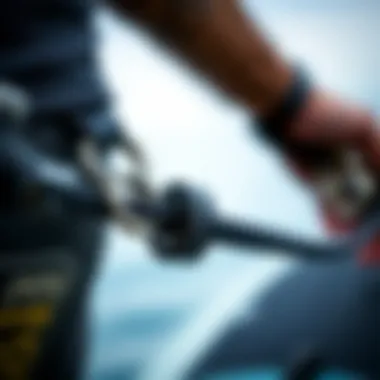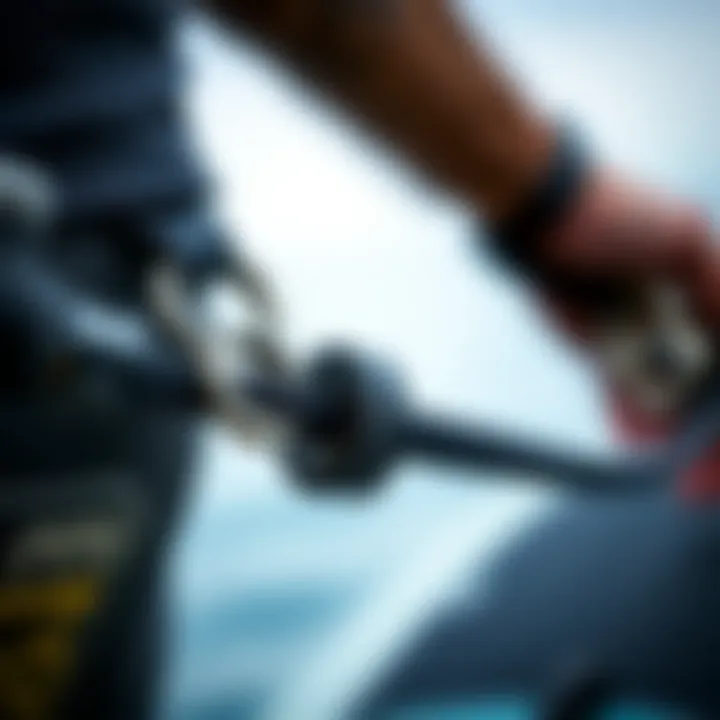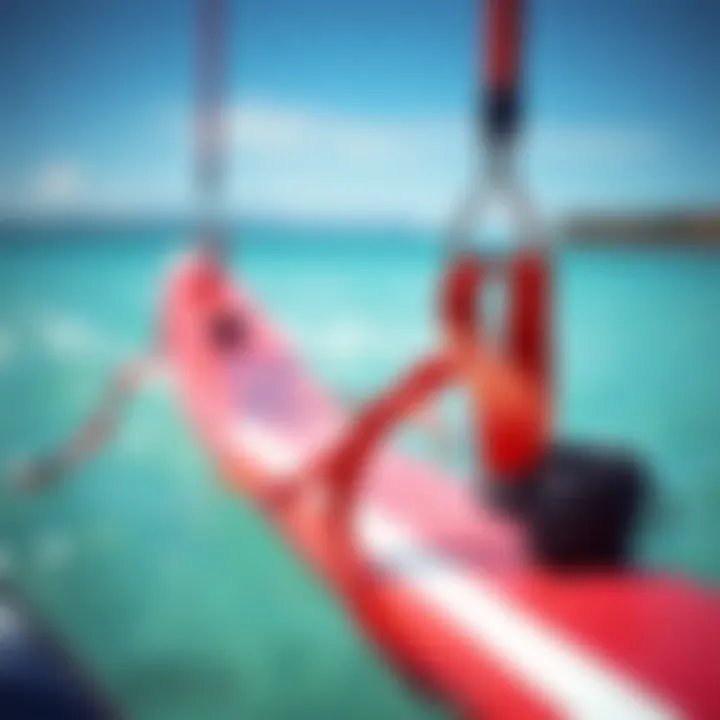The Role and Design of Hip Leashes in Watersports


Intro
In the realm of watersports, safety is a top priority, but it's not the only consideration that enthusiasts need to keep in mind. Equipment plays a critical role in enhancing both safety and performance on the water. Among the many pieces of gear, hip leashes have carved out a niche that blends practicality with innovation. Whether it's surfing, paddleboarding, or kitesurfing, these leashes serve as more than just a tether; they become an extension of the wearer, seamlessly integrating into the dynamics of the sport.
This article takes a closer look at hip leashes, discussing their design features, comparing them to other leash types, and offering practical tips for selecting the right one. By understanding the utility of hip leashes, we can appreciate how they contribute to a safer and more enjoyable watersport experience.
Preface to Hip Leashes
In the world of watersports, safety and performance often go hand in hand. Understanding the role of hip leashes, for instance, can dramatically change how enthusiasts engage with their chosen sport. Hip leashes are expertly designed to provide both freedom of movement and security, crucial for activities like surfing, paddleboarding, and kitesurfing. This article delves into the many facets of hip leashes—exploring their benefits, design intricacies, and their historical evolution.
The watersports community has increasingly embraced hip leashes due to their unique benefits. Unlike traditional ankle leashes, hip leashes offer a new level of convenience. They provide stability and allow for easier handling of the board—ideal for those dynamic moments when agility matters most, say when navigating choppy waters or during a high-octane wave ride.
Jumping into why this topic is significant: hip leashes also influence safety protocols within the watersports ecosystem. When leveraging a hip leash, riders may find themselves better in tune with their boards, leading to fewer accidents. This can be especially important for amateurs and instructors who need reliable gear to enhance their learning environment.
In this guide, readers will be led through an overview of hip leashes, their historical context, and a more compact understanding of materials and designs used in modern hip leashes. The goal is to ensure that every adventurer on the water is well-prepared, informed, and empowered to choose the best fitting gear for their journey. Understanding hip leashes goes beyond mere accessories; they are a gateway into heightened awareness and connection with the water.
The right hip leash is not just a tool; it's an extension of the rider’s capability to perform and stay safe.
As we venture into the details, expect to discover insights on the technological advances and assorted designs that keep hip leashes at the forefront of watersport gear. This exploration promises to guide newbies and seasoned pros alike through the ever-evolving landscape of hip leashes, ensuring everyone can ride those waves with confidence.
Design and Construction
Design and construction are paramount when it comes to hip leashes, acting as the foundation for their overall effectiveness in a variety of watersports. The right design not only influences performance but also ensures safety and enhances the experience for users. A thoughtfully designed hip leash can provide the user with ultimate mobility and ease of use, catering specifically to the unique demands of activities such as surfing, paddleboarding, or kitesurfing. Factors like materials, attachment mechanisms, and customization options come together to create a functional and reliable product.
Materials Used in Hip Leashes
When diving into the materials used in hip leashes, one finds a variety of choices that can affect performance and durability. Generally, high-quality nylon and polyester are the preferred materials due to their strength and resistance to abrasion. Additionally, some leashes incorporate neoprene padding for comfort, especially important during long sessions on the water.
Another interesting aspect to consider is the use of marine-grade stainless steel for clips, which can withstand saltwater corrosions, ensuring longevity. Users should also pay attention to the thickness of the tether; a thicker tether can provide more durability but may impede buoyancy slightly, which is something to ponder based on personal preferences.
It’s crucial for users to select leashes crafted from UV-resistant materials since exposure to sunlight can degrade the integrity of the leash over time. Investing in a leash that utilizes these advanced materials can indeed make a difference in both performance and lifespan.
Attachment Mechanisms
The mechanism through which the hip leash attaches to the user is another critical element that should not be overlooked. Most hip leashes utilize a quick-release mechanism that allows for instant detachment in case of an emergency. This aspect is vital, as it can mean the difference between a minor snag and a serious safety hazard.
Popular methods include:
- D-ring connectors, which offer security and ease of use.
- Buckle closures, often found in adjustable leashes, allow for customizable fit.
- Loop systems provide an additional layer of convenience, enabling users to attach or detach the leash efficiently.
Moreover, the ease of adjustment can enhance user comfort significantly. A well-designed attachment system not only keeps the leash securely in place while allowing freedom of movement but also fosters a more enjoyable experience on the water.
Customization Options
Customization has become an important facet of hip leashes, giving users the power to tailor their gear to specific preferences. When looking at customization options, one finds that colors, lengths, and padding can all be adjusted to suit individual needs. With some brands, users can choose from a spectrum of colors that complement their paddleboards or surfboards, adding a touch of personality to their gear.
Furthermore, the length of the leash matters – short leashes can provide more contact with the board, enhancing maneuverability, while longer ones offer additional freedom of movement.
Users may also consider options for padding; some leashes come with extra cushioning for skin comfort during intense activities. This aspect shouldn't be ignored, especially for those planning to spend extended periods engaging with their watersport of choice.
Customizing a hip leash ensures that the user has a product that not only fits well but also meets their performance expectations, leading to a more fulfilling and enjoyable experience on the water.
This segment on design and construction lays the groundwork for understanding how these factors impact functionality, a theme that will be explored more extensively in the sections that follow.


Functionality and Benefits
Understanding the functionality and benefits of hip leashes is crucial for anyone involved in watersports. These leashes aren't just an afterthought; they play a central role in ensuring safety, enhancing performance, and providing convenience across various aquatic activities. By examining specific elements of hip leashes, we can see how they align with the needs of modern enthusiasts.
Safety Aspects
One of the first things to highlight about hip leashes is their contribution to safety. In the heat of the moment, when a wave crashes or a gust of wind catches a watercraft, the need to maintain connection to one's gear becomes crucial. Hip leashes keep the rider tethered to their board or kayak, reducing the risk of separation.
- Immediate Retrieval: If a yard sale happens, and the board gets tossed about, a hip leash permits quick access. Instead of swimming back to retrieve a wayward board, it stays close, avoiding possibly costly retrieval.
- Increased Visibility for Others: When surfing or paddling in crowded areas, a bright, visible hip leash can alert surrounding watersports enthusiasts to your presence, minimizing accidents.
- Personalized Adjustability: Many modern designs now come with quick-release mechanisms. If an emergency arises, these allow for swift detachment, ensuring the user can react without being hindered.
Impact on Performance
Performance can often make or break a session on the water. Hip leashes are designed to reduce drag while allowing for maximum mobility. Unlike ankle leashes that can bind your leg movements, hip leashes sit higher and permit unrestricted motion. This slight change can enhance balance, stability, and overall maneuverability.
- Improved Fluidity: The feeling of freedom in movement allows for better transitions and surf maneuvers. It’s like taking a dance class compared to a martial arts session; each requires a different kind of movement.
- Less Risk of Injury: Ankle leashes may cause issues when a rider falls. A board can jerk back unexpectedly, potentially causing injury, while hip leashes mitigate this risk by offering a different catch point in the case of a wipeout.
Convenience in Various Watersports
When it comes to convenience, hip leashes are incredibly helpful in various watersport activities such as surfing, paddleboarding, and kitesurfing. Each sport has its unique demands, and hip leashes provide versatile functionality.
- Adaptable Usage: Whether you’re chilling on a paddleboard or racing on a kiteboard, a hip leash fits seamlessly into your gear, adapting to your needs.
- Enhanced Gear Management: Having a leash at hip level means not having to deal with cumbersome ankle bindings. It saves time when transitioning between activities, effectively making life easier for riders.
- Fashionable and Functional: With increasing popularity, many hip leashes now come with aesthetic touches. They match a rider's gear while serving their purpose, combining flair with utility.
As watersports continue to evolve, so too do the designs and functionalities of hip leashes. Understanding their value not only enhances safety but also optimizes the overall enjoyment of aquatic experiences.
Comparative Analysis
In the discussion of hip leashes, a comparative analysis is invaluable. This section not only elucidates the functional differences between various types of leashes but also provides insights into why choosing the right one is crucial for both safety and performance in watersports. By understanding what sets hip leashes apart from ankle leashes, enthusiasts can make informed decisions tailored to their needs. Moreover, diving into the adaptability of these leashes across diverse conditions informs users how best to employ them for maximum efficiency and comfort.
Hip Leashes vs. Ankle Leashes
When it comes to hip leashes and ankle leashes, frquently folks may not recognize the nuanced differences that influence their watersport experience. The first thing to note is the attachment point. Hip leashes are worn around the waist, providing a different pull point when a rider falls. This can be a game-changer in situations where quick maneuverability is essential. Marginally less restrictive than ankle leashes, they allow for a more significant range of motion, which is particularly beneficial in activities like kiteboarding or surfing.
In situations of sudden falls, a hip leash can quickly detach from the rider’s body, mitigating the risk of underwater entanglements. On the flip side, ankle leashes offer a tighter fit but can create drag when paddling in and out of waves. This may not only slow performance but also cause balance issues.
Benefits of Hip Leashes:
- Greater freedom of movement.
- Quick release in emergencies.
- Decreased risk of underwater entrapment.
Drawbacks of Ankle Leashes:
- Can be restricting, affecting agility.
- Higher chance of entanglement in rough waters.
Adaptability in Different Conditions
The environment in which watersports enthusiasts find themselves can be wildly varied, from flat waters to chaotic surf, and that’s where the adaptability of hip leashes truly shines. Unlike ankle leashes, hip leashes can serve well in shallow waters where the risk of falling is higher, yet water depths can vary dramatically. They tend to be more forgiving in terms of handling while negotiating rocky or uneven seabeds.
Moreover, the design of hip leashes often allows for a snug fit that secures gear even in high-wind conditions. Windsurfers and kite surfers, for instance, can benefit immensely from a hip leash that allows them to perform complex maneuvers without the leash becoming a hindrance. In contrast, in calmer waters, the less restrictive nature of a hip leash ensures the rider can react quickly to changing waves or surface conditions.
Key Considerations:
- Select hip leashes designed for specific environments.
- Check for adjustability features for a tailored fit.
- Consider attachment methods that suit your style of riding.
By understanding the differences between hip leashes and ankle leashes, along with how they adapt to different conditions, watersports enthusiasts can choose the best option for their personal experiences. Armored with this knowledge, anyone can hit the water more confidently, knowing their gear aligns well with their activities and environments.
"The right gear can make all the difference. It’s not just about safety; it’s about how it enhances the ride."


A thoughtful comparison helps demystify the selection process in a world where the right tool for the job can distinguish a memorable experience from a chaotic one.
Choosing the Right Hip Leash
When it comes to watersports, the right equipment can make or break your experience. One of the often-overlooked items in a watersport enthusiast's gear list is the hip leash. Choosing the right hip leash isn’t just about the color or brand; it involves understanding the specific demands of your sport, as well as personal comfort and safety.
Tailoring Your Selection
Picking the appropriate hip leash can enhance your confidence in the water. This is particularly true for surfers, paddleboarders, and kitesurfers who engage in varied environments. The right leash will provide not just security but also freedom of movement, ensuring your performance isn’t compromised.
"A proper hip leash is like a well-fitted seatbelt; it doesn’t restrict your function but protects when things go south."
Factors to Consider
When deciding on the right hip leash, there are several key elements to keep in mind:
- Length and Size:
The length of the leash can significantly impact your experience. For instance, a shorter leash is less likely to drag in water, while a longer one can offer more mobility. Think about your height and body type in conjunction with the type of watersport you practice. - Materials and Durability:
Look for hip leashes made of strong materials resistant to wear and tear, especially when dealing with saltwater environments. Neoprene and high-quality nylon are common choices for durability. - Attachment Mechanisms:
Consider how the leash attaches. A reliable attachment that allows for quick release in an emergency can be vital. Some models incorporate stainless steel clips, while others may use Velcro systems for quick detachability. - Comfort:
Remember, you’ll be wearing this leash for hours. Look for padded options that won’t chafe against your skin. Some leashes come with neoprene padding that enhances comfort without sacrificing security. - Weather Resistance:
If you find yourself out in different weather conditions, make sure you choose a leash that can withstand various environmental factors such as UV rays, salt, and even heavy rain.
Brand Comparisons
There is a plethora of brands in the market, and each offers unique features that cater to specific needs. Here’s an overview of some popular brands, helping you discern what might fit best:
- Dakine:
Known for high durability and good comfort, Dakine hip leashes are a favorite among surfers. They offer a variety of lengths and attachment systems, ensuring there’s something for everyone. - Rip Curl:
Often focused on a sleek design aesthetic, Rip Curl leashes don’t compromise on safety. Their products frequently feature reinforced stitching and quality materials. - Ocean & Earth:
This brand prides itself on innovative designs and high-functionality leashes. They have patented quick-release mechanisms that appeal to those who prioritize safety. - C-Skins:
More popular with kite surfers, C-Skins offers specific leashes that adapt to the unique needs of the sport. Their products blend both comfort and advanced materials for optimal performance.
Choosing the right hip leash is essential for your enjoyment and safety in the water. Take your time to evaluate these factors and don’t be afraid to consult experienced peers or reviewers. Engaging with different brands helps you understand which features align with your needs, ultimately enhancing your overall experience in the watersport of your choice.
Emerging Trends in Hip Leash Design
The watersports community is continuously evolving, and as it progresses, so too does the equipment we rely on, including hip leashes. This section addresses some of the most significant emerging trends in hip leash design, focusing on how they enhance performance, safety, and sustainability. Understanding these trends is crucial for enthusiasts who want to stay ahead of the curve and ensure their gear meets their needs while providing maximum enjoyment.
Innovations in Materials and Technology
In recent years, advancements in materials have changed the landscape of hip leashes. Manufacturers have begun using high-tech fibers that offer enhanced durability and strength without adding excessive weight. For instance, some brands are now incorporating Dyneema or similar composites. Such materials not only resist abrasion but also feature lower stretch properties, which might lead to improved responsiveness during high-energy activities like kitesurfing and wakeboarding.
The integration of smart technology is also gaining traction. Some hip leashes now come equipped with built-in sensors that monitor performance metrics, such as line tension or load impact, sending real-time data to a smartphone app. This technological leap helps riders refine their techniques and engage in safer practices, ultimately boosting their overall skill levels.
Key Innovations Include:
- Lightweight construction using advanced synthetic materials.
- Wear-resistant coatings that prolong the lifespan of the leash.
- Bluetooth technology for activity tracking and performance analytics.
- Adaptive designs that adjust to different water conditions, ensuring optimal performance.
Sustainability Considerations
Sustainability is high on the agenda across various industries, and watersports are no exception. As consumers become more ecologically conscious, manufacturers are feeling the pressure to adopt sustainable practices. Many hip leashes are now being produced with recycled materials, such as PET plastic or bio-based options that reduce environmental impact.
Moreover, sustainability goes beyond materials. Several companies are emphasizing ethical manufacturing processes, ensuring that their production lines benefit the communities involved. This approach resonates well with eco-minded consumers who prioritize buying from brands that uphold ethical standards.
Considerations in Sustainable Design:
- Use of recycled or eco-friendly materials in construction.
- Lower environmental impact during the manufacturing process, reducing carbon footprints.
- Transparent supply chains, allowing consumers to understand where and how products are made.
"The future of hip leashes is not just about performance; it's about responsibility towards our waters and the communities that depend on them."
User Experiences and Testimonials
When discussing the utility and design of hip leashes in watersports, engaging with user experiences and testimonials can't be overlooked. This first-hand perspective brings to light how these leashes truly perform beyond brand claims and product descriptions. Such accounts showcase real-life applications of hip leashes, highlighting their advantages and potential shortcomings while also providing insight into the broader community's sentiment.


Personal Accounts from Watersports Enthusiasts
Individual experiences can resonate powerfully, offering a snapshot of how various watersports enthusiasts view the functionality of hip leashes. Many surfers have shared stories from the surf line-up, where the flexibility of a hip leash has allowed for quick retrieval of their boards without hindrance. A surfer from California described a moment where, during a challenging session, his hip leash’s design allowed him to dive under waves seamlessly. “It’s like having a personal assistant out there,” he recounted, adding that the ease of movement made his experience far less stressful.
Meanwhile, paddleboarders often emphasize the leash’s role in safety while navigating through busy waters. One paddleboard instructor noted, "My students feel much more secure knowing that in case of a fall, the board won’t drift off too far. It keeps the lesson flowing, and that’s what matters, right?" This demonstrates how hip leashes can impact not just individual performance, but also the effectiveness of instructional settings.
On the other hand, not all experiences are glittering. Some users voiced concerns, particularly regarding comfort and attachment security. A kitesurfer mentioned that the hip leashes can sometimes become cumbersome, especially during prolonged use. "There’ve been times I’ve felt them digging into my hips. It’s not a deal-breaker, but something to keep in mind when sizing up or choosing materials.” These perspectives underline the diversity in user experiences, which can vary based on different factors—be it the sport, conditions, or even personal preferences.
Expert Endorsements
Professional endorsements play a pivotal role in validating product choices. Experts in the watersport community often lend their voices to share insights based on extensive use of hip leashes in various conditions. For instance, seasoned instructors frequently highlight how hip leashes enhance performance and safety, especially when managing groups in tumultuous environments. One renowned surfing coach stated, "The right hip leash acts as a safety net. It ensures that when students fall, their boards are right there, preventing potential collisions while giving swimmers peace of mind."
Furthermore, gear reviewers have become vital voices in the conversation. They dissect products for features that matter most to performance—durability, materials, and usability. A popular reviewer on platforms like Reddit pointed out that the most reliable hip leashes feature reinforced stitching and quick-release mechanisms, essential for any serious watersport enthusiast. "You don’t want to be fumbling in a critical moment. Look for leashes that provide those details. They may seem small, but believe me, they matter."
Expert opinions serve not only as endorsements but as a guide for users looking to make informed decisions. These validations affirm the importance of design and functionality in real-world contexts, driving home the point that while user experiences can differ dramatically, expert input provides a framework from which enthusiasts can glean insightful recommendations.
Personal and expert endorsements combined create a comprehensive narrative about hip leashes that is invaluable for both newcomers and seasoned participants alike.
Ultimately, the exploration of user experiences and testimonials reveals a dynamic landscape where personal preference converges with informed expertise, adding layers of depth to understanding hip leashes in watersports.
The Future of Hip Leashes
As technology and techniques in watersports continue to evolve, the future of hip leashes presents an exciting intersection of innovation, safety, and user experience. These essential pieces of gear, often overlooked, are gaining traction as critical components for various activities like surfing, paddleboarding, and kitesurfing. With a landscape that's constantly shifting, understanding what lies ahead in hip leash design can provide both enthusiasts and professionals valuable insight into maximizing performance and safety on the water.
Anticipated Developments
Looking ahead, several key trends and advancements are likely to shape the future of hip leashes.
- Smart Technologies: Imagine hip leashes integrated with smart technology, such as built-in GPS trackers or sensors that can signal distress during unforeseen situations. These advancements would cater particularly to those engaging in more extreme watersports where safety can be compromised.
- Enhanced Materials: As materials science progresses, we can expect the development of new, lightweight, and more durable materials. Companies could focus on eco-friendly options, ensuring not just performance but also environmental sustainability.
- Modular Designs: Future hip leashes might adopt modular designs, making them easy to customize according to different activities or individual preferences. For instance, a paddleboarder may want a leash that incorporates features focused on buoyancy, while a surfer may avoid that for a sleeker model.
These anticipated developments undoubtedly hold promise for enriching the hip leash market, aligning gear functionality with the needs of modern watersports enthusiasts.
Integration with Other Gear
One of the significant trajectories for hip leashes is their potential integration with other watersport gear. This brings several advantages:
- Seamless Connectivity: A more integrated approach can create a cohesive experience across gear. Imagine a user’s wetsuit connected to the hip leash, providing feedback about conditions or physical exertion. This kind of synergy can enhance overall performance.
- Multi-Functional Features: Hip leashes that double as carry straps or storage compartments could be incredibly useful. Picture a situation where your leash can transform seamlessly into a way to secure equipment when not in use, cutting down on the need for carrying multiple items.
- Safety Enhancements: Integration can also lead to improved safety features. For example, a harness system that interfaces with the hip leash could ensure that in case of any fall or accident, it can help the user stay connected to their board or equipment.
The prospect of weaving hip leashes into the broader ecosystem of watersports gear is not merely about innovation; it’s about redefining the user experience. As watersports enthusiasts continue to demand more from their equipment, manufacturers will likely rise to the occasion, creating solutions that enhance safety, performance, and convenience.
"The future isn't something you enter. The future is something you create." — Leonard I. Sweet
As we progress into the next era of watersports, we should keep our eyes peeled for these advancements, as they promise to redefine how we interact with our sport and enhance our safety while having the time of our lives.
End
Wrapping up this exploration of hip leashes, it’s clear that these devices play an indispensable role in the realm of watersports. While most simply consider them as a safety tool, their impact stretches far beyond that. In the multifaceted world of surfing, paddleboarding, and kitesurfing, hip leashes elevate not just safety but the entire experience on the water.
Summary of Key Insights
Throughout the article, we’ve delved into several important facets:
- Safety and Performance: We highlighted how hip leashes provide security while allowing athletes to maintain high performance. They enable quicker movement and greater freedom than their ankle counterparts.
- Customization: The versatility in design offers users the chance to choose leashes that fit their personal style and their specific watersport activities. This customization can enhance the overall enjoyment and safety of one’s experience.
- Emerging Trends: Innovations, particularly in materials and technology, are paving the way for more sustainable and effective designs. As the world moves forward, hip leashes will likely evolve to meet the needs of this growing community.
"In watersports, the right gear can transform a good day on the water into a memorable one. Hip leashes serve as not just safety devices but also a key element of performance enhancement."
Final Thoughts
As we glance ahead, it’s essential for enthusiasts of all levels to recognize the significance of choosing the right hip leash. Understanding the nuances within design, functionality, and the latest trends can have a profound impact on your watersport pursuits.
There is no doubt of their utility in enhancing the rider's experience, from providing a reliable connection between the board and the rider to serving as a lifeline in challenging conditions. Future developments promise to address environmental sustainability while improving user comfort and performance. It's clear that hip leashes are not merely accessories; they are an integral part of any serious watersport gear, merging safety with style efficiently.



